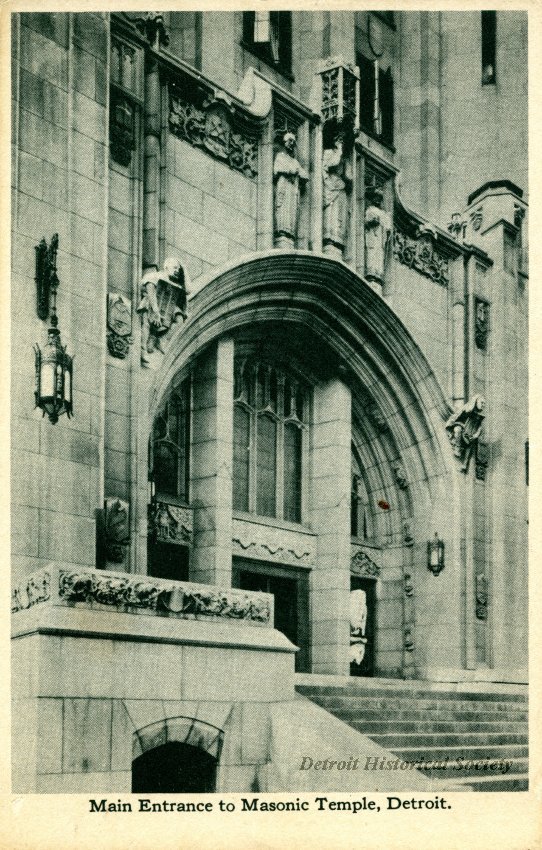Detroit’s Masonic Temple – the largest in the world at roughly 12 million cubic feet – was designed by renowned local architect George D. Mason.
The Largest Masonic Temple
 The temple is an imposing Gothic structure at the corner of Bagg Street (later Temple Street) and Second Avenue, across from Cass Park. Within its walls are a large cathedral, several chapels, two stylish ballrooms, hotel facilities, a library, a massive drill hall, and a 4,000-seat auditorium featuring the largest professional stage in the city. It was designed to accommodate over 40 individual masonic lodges. The architect and mastermind behind the building was George D. Mason.
The temple is an imposing Gothic structure at the corner of Bagg Street (later Temple Street) and Second Avenue, across from Cass Park. Within its walls are a large cathedral, several chapels, two stylish ballrooms, hotel facilities, a library, a massive drill hall, and a 4,000-seat auditorium featuring the largest professional stage in the city. It was designed to accommodate over 40 individual masonic lodges. The architect and mastermind behind the building was George D. Mason.
George G. Mason was born in Syracuse, New York in 1856 and in 1870 his family relocated to Detroit.
In 1875 he began working for Hugh Smith —a local architect. He quickly switched to the firm of Henry T. Bush, where he took on the work of the George O. Robinson House, Detroit Public Library and the Ransom Gills House.
Mason broke from the firm, establishing Mason & Rice in 1878 with Zachariah Rice. From 1884 to 1896, Albert Khan — who would become another famed Detroit architect, worked with the firm. Mason & Rice dissolved in 1898 and Mason continued to work on his own, establishing Mason & Company.
Building the Masonic
After Mason struck out on his own, he designed significant buildings in Detroit like the Pontchartrain Hotel, Detroit Yacht Club and Herman Keifer Hospital.
During this time, interest in Masonic fraternities was growing in Detroit and the current spaces used by the various clubs in the city weren’t large enough to support expanding membership.
The fraternity purchased a block of land on Temple Street (formerly Bagg Street) and contracted Mason to design the building. Mason broke ground on the temple on Thanksgiving Day in 1920, and in 1922 the first brick was laid using a trowel – a symbol often associated with freemasons – used by George Washington to lay the first bricks at the U.S. Capitol in Washington D.C.
In 1926, the building was officially dedicated and opened to the public.
Debunking the Rumors
The Freemasons, the masonic fraternity the temple was built for, are often regarded as a mysterious group, with rumors swirling about their activities. But, one rumor about the architect of the largest Masonic Temple in the world, is loud enough for us historians to hear about.
Rumors are widely reported, even in news outlets, that George Mason overdid the spending on the construction of the temple causing bankruptcy. The rumor even goes on to say that his wife left him because of it.
And as the story goes, Mason – distraught over the loss of his finances and his wife, died by suicide by jumping off the top of the 210-foot building. The story is sensationalized by guards, docents and even event attendees claiming to see Mason’s ghost climbing the stairs to his death, closing windows, and stealing and hiding items.
While the story makes for great Halloween horror tale, it is not true. George Mason died in 1948 at 91 years old in his home in the Wilshire Apartment building on Grand Boulevard.
Maybe it's because the building was constructed for a secretive organization or because its imposing size dominates the neighborhood, but stories about the Masonic Temple and its haunted history reappear every year around Halloween. And while there might be ghosts hiding in the 1,037 rooms – we won’t be the ones to prove it and we’ll stick with the historic facts.
Read more about the Masonic Temple in our Encyclopedia of Detroit article and explore other spooky stories in our Haunted History blog series here.